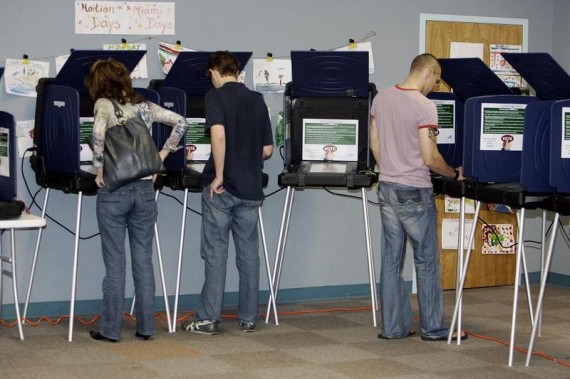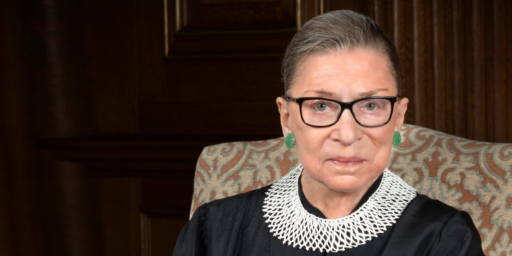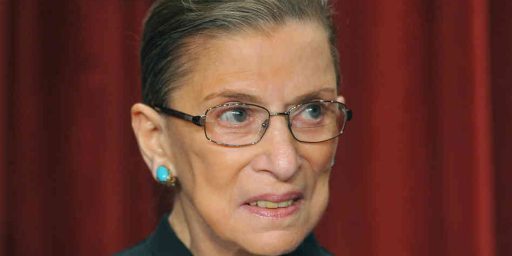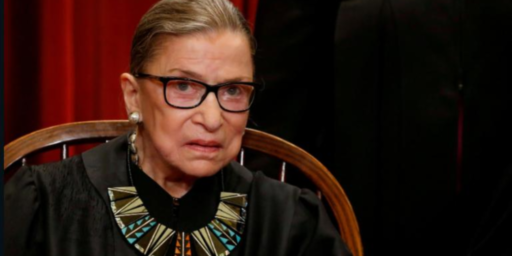Supreme Court Rejects Effort To Narrow Meaning Of ‘One Person, One Vote’
With surprising unanimity, the Supreme Court rejected an effort to restrict the meaning of 'one person, one vote' in legislative redistricting.
With somewhat surprising unanimity, the Supreme Court ruled today that states may continue to use total population to determine district lines for state legislatures, rejecting a challenge from a conservative group that would have had the Court mandate a more restrictive standard:
WASHINGTON — The Supreme Court on Monday unanimously ruled that states may count all residents, whether or not they are eligible to vote, in drawing election districts. The decision was a major statement on the meaning of a fundamental principle of the American political system, that of “one person one vote.”
As a practical matter, the ruling mostly helped Democrats.
Until this decision, the court had never resolved whether voting districts should contain the same number of people, or the same number of eligible voters. Counting all people amplifies the voting power of places that have large numbers of residents who cannot vote legally — including immigrants who are here legally but are not citizens, illegal immigrants, children and prisoners. Those places tend to be urban and to vote Democratic.
Had the justices required that only eligible voters could be counted, the ruling would have shifted political power from cities to rural areas, a move that would have benefited Republicans.
The court did not decide whether other ways of counting were permissible. “We need not and do not resolve,” JusticeRuth Bader Ginsburg wrote for six justices, whether “states may draw districts to equalize voter-eligible population rather than total population.”
Lyle Denniston analyzes the opinion:
Justice Ruth Bader Ginsburg wrote the main opinion in the much-anticipated case of Evenwel v. Abbott, and a hasty reading of it might suggest that the states must use one formula in drawing election maps: take the total number of people in a state, then divide up that total by the number of seats in the legislature or local governing bodies, and that dictates how many people (give or take a few) should be in each district. But that is not where the Court wound up.
While virtually every argument used by the Ginsburg opinion in favor of basing representation on total population (because elected officials supposedly represent everybody and not just the voters) points toward a constitutional mandate, it turns out that the states actually are not bound by the Constitution to craft new election districts by starting with total population. The only thing settled constitutionally now is that the states also are not required to divide up districts by using the voting population to be assigned to each, making them equal. Should a state do it that way, the opinion seems to say, the Court will face that when it happens.
The ruling’s bottom line was unanimous, but the main opinion bore many signs that its warm embrace of the theory of equality of representation had to be qualified by leaving the states with at least the appearance of the power of choice, in order to hold together six solid votes.
Two of the eight Justices were clearly not satisfied with the rhetoric and some of the implications of Justice Ginsburg’s opinion, and only joined in the outcome. Those were Justices Samuel A. Alito, Jr., and Clarence Thomas, each of whom wrote separately. Thomas also joined most of Alito’s opinion.
Had Justice Ginsburg not held five colleagues in support of what her opinion actually said in the end, two — perhaps Chief Justice John G. Roberts, Jr., and Justice Anthony M. Kennedy — might have abandoned the common result. The result then might have been that the Court would have split four-to-four, settling nothing and releasing no opinion at all while leaving intact a three-judge federal district court’s ruling that Texas had the authority to base its state legislative seats on a division of the total population of Texas.
Texas actually had wanted the Court to allow it to use a total population metric, but to go further and give the states explicit constitutional permission to map out districts with equal populations of voters. The Obama administration also had wanted the Court to rule that the Constitution actually required total population as the starting point for redistricting. Neither persuaded the Court to go take those further steps.
Justice Alito used his separate opinion to try to make it very clear — to legislatures and to lower courts — that the Court decision did, indeed, stop short of those added points. He wrote: “Whether a state is permitted to use some measure other than total population is an important and sensitive question that we can consider if and when we have before us a state districting plan that, unlike the current Texas plan, uses something other than total population as the basis for equalizing the size of districts…For centuries, political theorists have debated the proper role of representatives, and political scientists have studied the conduct of legislators and the interests that they actually advance.”
Justice Thomas used his lengthy opinion to chastise the majority for even trying to figure out what one-person, one-vote should mean as a constitutional matter, and should leave such issues to the states to decide. Under the Constitution, he wrote, a state “can use total population, eligible voters, or any other nondiscriminatory voter base.”
Joining in the Ginsburg opinion, and offering no separate views, were the Chief Justice and Justices Kennedy, Stephen G. Breyer, Elena Kagan and Sonia Sotomayor.
Perhaps the most surprising thing about this case was the fact that we ended up with a unanimous opinion. When the case was argued back in December, the Justices seemed to be sharply divided on the meaning of ‘one person, one vote,’ and how it applied to the case at hand. Some Justices appeared to buy the Plaintiff’s argument that the entire principle meant that it should only be voting age population — either the population of those eligible to vote or the population of actual registered voters — that should determine the make up of state legislative and other districts. Others believed that districts needed to be drawn based on total population since representatives are presumed to represent all the people who live in their districts, not just the people who are eligible to vote, the people who actually did vote, or the people who voted for them. The fact that the Justices were able to pull together a unanimous opinion from the disagreement we saw at oral argument is thus somewhat surprising, though it may be reflective of a reality in dealing with the case that manifested itself after the death of Justice Scalia that resulted in a change in how the Justices chose to deal with the case. The fact, for example, that the opinion does not mandate a standard but rather says that total population is not an impermissible method for states to use in drawing the lines of state legislative districts or other political subdivisions. Left unstated is the question of whether some other other standard, such as basing redistricting on voting population instead of total population, or whether states may use some other method to create districts. That, presumably, is an issue for future cases. At the very least, though, what is clear is that the Court rejected the argument of the Plaintiffs that the states should be required to use a standard based on the population of eligible or registered voters.
As I noted when the Court initially accepted this case, the Plaintiff’s argument never seemed to make sense. For one thing, while the Constitution is silent on what standard states should use in drawing district boundaries, the fact that the Founders did provide that Congressional Districts should be drawn based on total population is arguably a strong indication of how they felt about the matter generally. More importantly, though, the fact that representatives such as state legislators are deemed to represent everyone in their district, regardless of whether they are eligible to vote or not, argues strongly in favor of the idea that the standard used to draw district lines should be based on something broader than just voting eligible population or the far more restrictive standard of the population of eligible voters. Indeed, using one of those more restrictive standards would seem to me to be inherently unfair to those who are not eligible to vote since it deprives them of equal representation in government and, arguably, equal protection of the law as guaranteed under the Fourteenth Amendment. Given this, it strikes me that the Court mostly got the decision right in this case, although the failure of the Justices to establish something more of a definitive standards for cases going forward is unfortunate and would only seem to guarantee that they will be deal with this issue again in the not too distant future. For now, though, they did fairly well here for the most part.
Here’s the opinion:





Unanimity isn’t that surprising, Doug. The majority of cases decided by the Court last term were either 9-0 or 8-1.
That actually makes sense and should renew our faith in the system. It also might make us think: the 5-4 decisions probably should never had made it to the Court to begin with. They should have been decided by the Congress.
@Dave Schuler:
True.
Also true: some of them were!
As I said in the fall, the argument was clearly with the state and I’m glad the Court decided that way. Congressmen represent the people, with their representation allocated by population whether those people can vote or not (see, e.g,, the 3/5 compromise which counted slaves as 3/5 of a person without allowing them to vote). The exact method by which those legislators are chosen is up to the states. Whether it’s by voting from white property owners or voting by everyone or consulting sheep entrails, the method does not change whom they represent.
Also a reminder that oral arguments are sometimes a poor indication of where the Court is going on an issue. Often judges are trying out arguments or playing devil’s advocate. The oral arguments were contentious but, in the end, all the judges were on the same side.
@Dave Schuler: Some of the 5-4 decisions I’ve read aren’t because the judges have differing opinions about the law–sometimes it’s because they’ve all decided “yeah, this is a screw-up here”, and the more activist judges think that SCOTUS should fix it while the others think that it’s really a problem for the legislature to fix.
(Often occurs in SCOTUS decisions involving IP, I’ve noticed. Not helped by SCOTUS’s eagerness at shooting down every single time the Federal Circuit tries to come up with a bright-line IP rule.)
Remember kids – this lawsuit happened solely because the party of small government decided they can’t win an election unless they keep the wrong people from voting.
Tax day is coming up, remember that at least a small chunk of your annual donation to the federal government went to support this tripe.
@grumpy realist:
It will probably be another 30 years before the majority of the Court will have grown up in a digital world. Sensible IP law will probably have to wait for that generation; I don’t see much hope of getting it from technologically illiterate liberal arts majors who grew up sharpening their own quills.